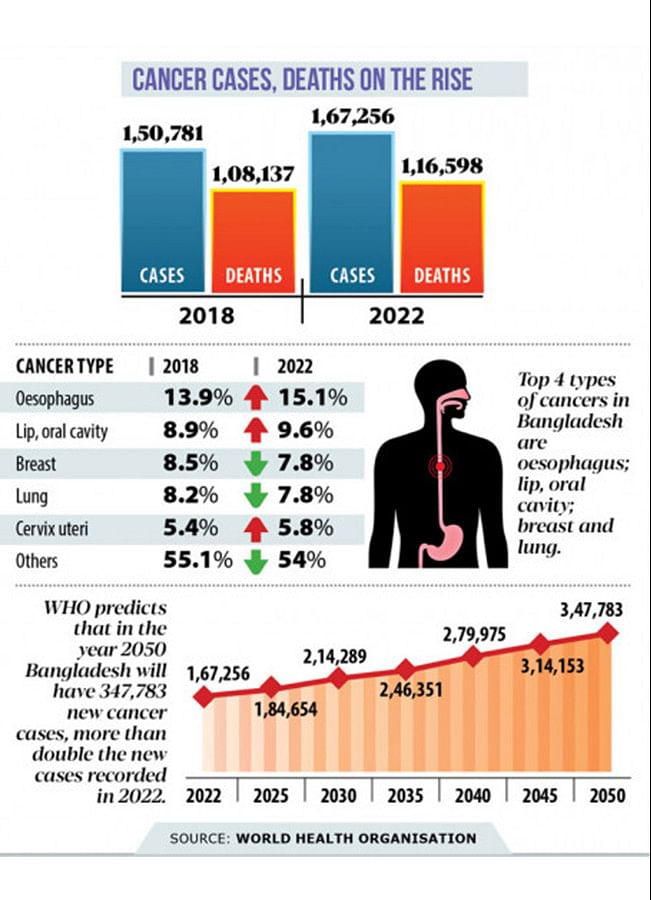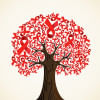Cancer increasing in Bangladesh, may double in 2050

The number of cancer patients is steadily increasing in Bangladesh, and in the year 2050, the country may record more than double the new cases of 2022, according to a World Health Organization report.
The report was prepared based on data from 185 countries and 36 types of cancers. Regarding Bangladesh, it says oesophagus, lip, oral cavity and lung cancers are the most common.
"Consumption of adulterated and junk food, sedentary lifestyle, tobacco and alcohol use are the key causes of the rising number of cancer cases in Bangladesh."
"Consumption of adulterated and junk food, sedentary lifestyle, pollution, and tobacco and alcohol use are the key causes of the rising number of cancer cases in Bangladesh. Hyper acidity is common in both men and women. That is why instances of oesophagus cancer are rising," Mollah Obayedullah Baki, former president of Bangladesh Cancer Society, told The Daily Star yesterday.
Experts say late screening raises the risk of fatalities in the country.
The WHO also predicts that in 2050 the number of new cancer cases across the world will reach 35 million, about 77 percent higher than the figure in 2022. Almost one in five people develop cancer in their lifetimes, with one in nine men and one in 12 women dying from the disease, the report adds.
The new WHO data is based on a survey conducted by the International Agency for Research on Cancer (IARC).
The study identified tobacco, alcohol, obesity, and air pollution as key factors behind the predicted rise globally.
Physicians in the country say the prevalence of lung cancer is high among men while breast and cervical cancers are most common among women.
Bangladesh, like the rest of the world, will observe World Cancer Day tomorrow. However, there is no national data on the disease in Bangladesh.
Professor M Nizamul Haque, director of the National Institute of Cancer Research and Hospital, said, "We need to commence an epidemiological study immediately to see the whole picture of cancer in the country. We have some hospital-based data, but it is not complete."
Noted cancer epidemiologist Habibullah Ruskin said, "There is no denying that the numbers of patients and fatalities are rising. But it is tough to say the extent of its rise without exact data."
There must be a national cancer control strategy under which there will be detailed plans of action and programmes, he said, adding that a proper cancer registration and screening system and treatment protocol must be in place.
"It is high time we bring all the cancer programmes under a single umbrella so that we can have proper data," he said.
The government last year launched a school-level HPV (human papillomavirus) vaccination programme to eliminate cervical cancer-related deaths, said Prof Haque, adding that hepatitis B and other vaccines are also preventing cancer-related deaths.
The WHO report says an estimated 9.7 million people died of cancer in 2022.
WHO also published survey results from 115 countries, showing a majority of countries do not adequately finance priority cancer and palliative care services, as part of universal health coverage.
The new estimates available on IARC's Global Cancer Observatory show that 10 types of cancer collectively comprised around two-thirds of new cases and deaths globally in 2022.
Lung cancer was the most commonly occurring cancer worldwide with 2.5 million new cases, followed by 2.3 million breast, 1.9 million colorectal, 1.5 million prostate, and 970,000 stomach cancer cases.
Lung cancer caused 1.8 million deaths, colorectal cancer 900,000, liver cancer 760,000, breast cancer 670,000 and stomach cancer 660,000.
Freddie Bray, head of cancer surveillance at IARC, said, "Those who have the fewest resources to manage their cancer burdens will bear the brunt of the global cancer burden."

 For all latest news, follow The Daily Star's Google News channel.
For all latest news, follow The Daily Star's Google News channel. 








Comments